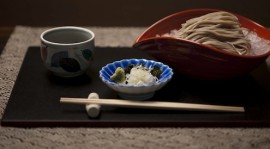
SNAPSHOT
| Population |
35.7 million |
| Cuisine | Japanese |
| Signature dishes | Seasonal multi-course meal (kaiseki), raw fish over vinegared rice (sushi), deep-fried shrimp (shrimp tempura), soba and udon noodles, skewered grilled chicken (chicken yakitori) |
| Wine culture | Asia’s most mature wine market and largest wine importer by volume and value |
| Wine duty | Approximately US$1.50 per bottle plus 5% consumption tax |

FOOD AND DINING CULTURE
Nearly everyone in Asia who is passionate about food goes through a love affair with Japanese cuisine. The first impression is one of amazement at the artistry and refinement in every bowl, every dish, and in every tiny morsel. The incredible attention to detail from the choice of ingredients, to their preparation and final presentation seems like a mini ceremony to the food gods. The second impression is one of deep respect. After delving more into such details as the art of cutting fish, preparing tofu, understanding the sequence of a kaiseki meal, there is much respect for those who make the effort and devote their lives to perfecting a small aspect of Japanese cuisine. The third impression is no longer an impression but an understanding that Japan’s food culture is a microcosm of all things Japanese: deference to nature and natural flavours, patience and hard work to master a skill, adherence to customs, respect for talented masters, emphasis on balance and an eye for harmony and visual appeal.
The very best Japanese chefs are obsessed, not with adding or altering flavour, but with taking away distracting flavours to best express the purity and essence of a dish or ingredient.
Asian gourmands have long paid homage to Tokyo. As the most advanced and wealthiest Asian country to emerge after the war, its dining scene soon grew in tandem with its economy. Restaurants proliferated and successful eating establishments survived only by finding their specialised niche.
CUISINE
For Tokyoites, sushi may be a home-grown favourite, but other dishes such as soba, ramen and yakitori have all been perfected in the city. As Japan’s capital since 1868, Tokyo has embraced Kyoto’s refined delicate cuisine brought over by the imperial family.
While it has many unique features, several stand out as being closely associated with Japanese food – appreciation for texture, the role of umami and the attention to eating sequence and visual appeal. For lovers of bold flavours, Japanese food may appear bland. A dish can be so intricate and subtle that enjoyment comes from balance, delicacy and texture. A slice of tuna sashimi may seem simple, but the variations are nearly infinite depending on the tuna source, its freshness, size, age, exact cut, the skill with which it was cut, the serving temperature and the quality of soy sauce and wasabi served along with it. Even different cuts from the same fish can have different names – lean tuna is called maguro and the fatty part of the tuna belly is called toro.
Eating sequence has long been a feature in Chinese banquet cuisine, however, the Japanese have elevated it to an art. An elaborate multi-course kaiseki meal in a traditional ryokan (Japanese inn) is a poetic experience. The courses follow a ritualistic precision from the sakizuki (amuse bouche) to the sashimi course, the simmered dish, the grilled dish, to the beautifully lidded bowl filled with seasonal ingredients. Just as important are the setting and the serving ware – kaiseki cuisine is often served in private rooms with a view of a tranquil scene such as a garden or a sculpted tree. Each bowl, plate or lacquer ware that is presented has been carefully chosen to complement the dish. The chef has considered the season and the weather and tried to ensure that there is harmony and refinement in the combination of flavours presented in a dish. For visual harmony, the five major food colours will have been considered – yellow, black, white, green and red.









